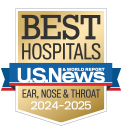Hearing Aids
The Audiology Clinic at the UC Davis Health Department of Otolaryngology provides a full scope of hearing aid services, including hearing aid dispensing, hearing aid accessories, hearing assistive technologies, and hearing aid repairs. All of our hearing aid dispensers are Doctors of Audiology and licensed Dispensing Audiologists by the state of California.
A hearing aid provides amplification (sound) by sending the sound through the whole ear system and is specifically programmed to the patient’s hearing loss, ear canal acoustics, and personal preferences. A hearing aid can help a patient hear better, but it will not restore hearing or make hearing “normal” again, however it can help provide good benefit in most listening situations.
Hearing Aid Evaluation: Our Audiologists meet with patients and family members to provide an assessment of the patient's needs, preferences, and budget; working with the patient and family, hearing aids are selected and fitted. A hearing aid evaluation is about 1 hour and requires a recent hearing test that shows an established hearing loss. A medical clearance form may be required by an Ear, Nose, & Throat Physician before amplification can be fitted. Your insurance may or may not cover the cost of hearing aids. Speak to your insurance representative to inquire further.
Audiologists will ensure that the hearing aids are appropriately fitted by using probe microphone Real-Ear Measurements to allow for a customized/prescribed fitting.
The hearing aid fitting process usually requires at least three appointments during the trial period.
As required by state law, all hearing aids are provided with a 45-day right-to-return policy.
Hearing Aids for Children
Our goal is to provide families with:
- The latest pediatric-specific hearing aid models from trusted manufacturers.
- Hearing aids selected with features that are important for babies and young children learning language and older children in their educational and social settings.
- Research- supported pediatric hearing aid fitting and verification protocols that will make speech and environmental sounds audible and accessible as well as comfortable and safe.
- Communication strategies that are consistent with each families’ communication goals for their child.
- Referral to educational programs and consultation with educators regarding classroom modifications / accommodations and hearing assistance technologies.
- Fostering of self-advocacy skills for children.


